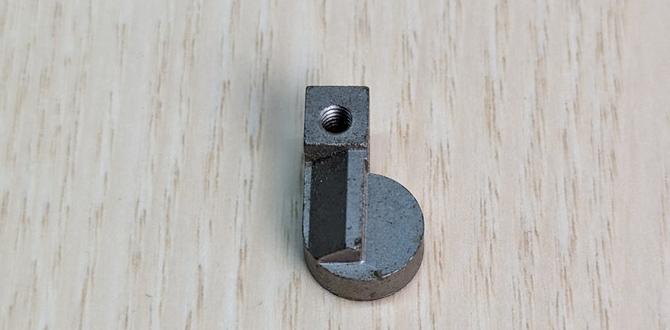Quick Summary: Spotting broken springs in your nailer is easier than you think! Look for physical damage like kinks or breaks, listen for odd noises during operation, feel for a loss of power or bounce, and test the spring’s tension. Early detection saves you time and frustration.
Hey DIYers! Jack Shaffer here from Nailerguy. Ever had your trusty nailer suddenly decide to take a siesta right in the middle of a project? It’s incredibly frustrating, and often, the culprit hiding within is a broken spring. These little workhorses are vital for your nailer’s performance, from driving nails consistently to returning the driver blade. When they’re not happy, your project stops dead in its tracks. But don’t worry! Identifying a broken spring doesn’t require a degree in mechanics. With a few simple checks, you can diagnose the problem and get back to building. Let’s dive into how to spot these hidden issues so you can fix them quickly and confidently.
Table of Contents
Why Spring Health Matters for Your Nailer
Think of the springs in your nailer like the springs in your car’s suspension. They absorb shock, provide return force, and generally keep things running smoothly. In a pneumatic nailer, for instance, springs work in tandem with air pressure to drive nails precisely. If a spring is damaged, it can’t perform its job effectively. This can lead to:
- Inconsistent driving: Nails might not be driven flush, or they might fly out with too much force.
- Misfires: The nailer might fail to fire altogether.
- Jamming: A weakened or broken spring can cause jams.
- Damage to other parts: A malfunctioning spring can put undue stress on other components, leading to more extensive repairs.
Regularly checking your tool’s springs is a proactive step that can prevent bigger headaches down the line. It’s all about keeping your tools in top shape for reliable performance.
Common Types of Springs in Nailers and Their Functions
Nail guns have several types of springs, each with a specific role. Understanding these helps in pinpointing the issue. The two most common types you’ll encounter are:
1. The Return Spring (or Piston Return Spring)
This is arguably the most critical spring for the operational cycle of many nailers. After a nail is driven, the piston is forced down. The return spring’s job is to quickly and powerfully pull the piston back up to its ready position, allowing the tool to accept another nail and prepare for the next cycle.
Signs of a faulty return spring:
- The driver blade (the part that strikes the nail head) doesn’t fully retract or seems sluggish.
- You hear a dull thud instead of a crisp firing sound.
- The nailer feels “weak” or lacks its usual punch.
- The tool requires manual assistance to reset for the next shot.
2. The Magazine Spring (or Feed Spring)
This spring is located in the magazine where the nails are stored. Its purpose is to push the strip of nails forward, ensuring that the next nail is always positioned correctly under the driver blade, ready to be fired. It’s usually a flat, coiled spring that gradually unwinds as nails are used.
Signs of a faulty magazine spring:
- Nail feeding issues are the most common symptom. Nails might get stuck in the magazine.
- The nailer might fire, but no nail comes out (often referred to as an “air shot” or “dry fire,” though this can have other causes too).
- You have to manually push the nails forward for them to be picked up.
- The last few nails in a strip consistently misfeed or don’t fire.
It’s important to note that other springs might be present in more complex nailer designs, such as those in trigger mechanisms or safety latches, but these two are the most frequent reasons for operational failure related to broken springs.
Proven Tips to Identify Broken Springs
Now, let’s get down to business. Here are some practical, hands-on tips to help you figure out if a spring is the troublemaker.
1. Visual Inspection: The First Line of Defense
This is the most straightforward method. Always start by looking. For a basic visual inspection, you usually don’t even need to disassemble the tool completely, especially for the magazine spring.
For Magazine Springs:
- Unload the nailer: Make sure there are no nails loaded.
- Open the magazine: For most nailers, you can slide open or unclip the magazine cover.
- Examine the spring and follower: Look for any obvious kinks, bends, breaks, or signs of corrosion on the spring itself. The “follower” is the piece that rides on the spring to push the nails. Ensure it moves freely.
- Check for obstructions: Sometimes, debris can get caught and prevent smooth carriage of the nails.
For Return Springs:
This often requires more disassembly. Consult your tool’s manual for specific instructions on how to safely access the driver and piston assembly. Common steps involve removing the nosepiece and then unscrewing or unclipping the main housing.
- Gently pull the driver blade: With the housing partially open, try to pull the driver blade back. If it feels unusually stiff, loose, or “grinds” as it moves, it could indicate a problem with the spring or its guide.
- Remove the spring (if accessible): Once you can see the return spring, carefully examine its coils. Look for any cracks, loops that are out of place, or if the spring has lost its’ coiled shape and is now stretched out like a limp noodle.
- Check the guide and housing: Ensure the spring is seated correctly and not rubbing against anything it shouldn’t be. A damaged housing can also shear a spring.
2. Listen to Your Nailer: The Sound of Silence (or Not!)
Tools often tell you what’s wrong if you pay attention. The sounds a nailer makes during operation can be quite telling.
- Weak or muffled firing sound: If the usual sharp “bang” is replaced by a duller “thump,” it suggests that the piston isn’t reaching its full speed or travel, often due to a weak return spring.
- Grinding or scraping noises: These can indicate a spring that’s not guided properly, binding, or rubbing against the housing.
- No sound at all: While this can mean a lack of air, a completely broken spring can also cause a dead cycle if it prevents the mechanism from engaging properly.
Record yourself using the nailer if you can, or have a friend listen. Comparing its current sound to how it used to sound can be a big clue.
3. Feel the Force: Power and Recoil Check
Your sense of touch can also be a great diagnostic tool.
- Reduced power: If nails are sinking inconsistently, not driving fully, or requiring multiple shots, a weak return spring is a prime suspect. It’s not pushing the piston with enough force.
- Excessive recoil: Sometimes, a broken spring might cause uneven force distribution, leading to a kickback that feels different or more jarring than usual.
- Driver blade not resetting: After firing, the driver blade should snap back cleanly. If it drags, feels “sticky,” or requires you to manually help it reset, the return spring is likely compromised.
A healthy nailer should feel responsive and have a consistent snap. Any deviation from that can be a sign of internal trouble.
4. Test the Spring Tension (When Accessible and Safe)
For some accessible springs, you might be able to do a rudimentary tension test.
- Magazine Spring: Try to push the follower by hand when it’s loaded with nails. It should offer firm, consistent resistance. If it’s too loose, or if you can push it with very little effort, the spring has likely lost its power.
- Return Spring: If you’ve safely removed the return spring, you can hold one end and try to compress or stretch it slightly. It should feel taut and springy. If it feels limp, has clearly lost its coiled shape, or if you can easily pull it to its full length without significant resistance, it’s almost certainly broken or severely weakened.
Safety Warning: When testing springs, especially return springs, be careful not to let them fly out and hit anything – or anyone! They can have significant stored energy.
5. Observe the Nail Feed Mechanism
This is particularly relevant for issues with the magazine spring and the feeding of nails into the firing chamber.
- Smooth Feed: With the magazine loaded (and the nailer depressed on a safe surface or the safety trip engaged), observe how the nails are presented. They should consistently arrive at the firing point.
- Jams in the Magazine: If you’re experiencing frequent jams behind the driver blade, it’s often a magazine spring problem. The nails aren’t being properly fed into position.
- Last Few Nails: A common symptom of a weak magazine spring is that the last few nails in a strip always misfeed or fail to fire. The spring just doesn’t have enough oomph left to push them all the way home.
A properly functioning magazine spring ensures a consistent and reliable flow of fasteners to the firing point. Any hesitation or inconsistency here points to a potential spring issue.
Tools You Might Need for Inspection
You don’t need a fully stocked mechanic’s toolkit for this, but a few items can make the inspection much easier and safer.
- Screwdriver Set: You’ll likely need Phillips and flathead screwdrivers, often with magnetic tips, to remove housing parts.
- Allen Wrench Set: Some nailers use Allen bolts for assembly.
- Pliers: Needle-nose pliers can be useful for carefully extracting or repositioning small springs or parts.
- Owner’s Manual: This is your best friend! It will show you how to safely disassemble your specific model. You can often find these online on the manufacturer’s website. For example, DEWALT’s support page offers manuals for their extensive range of tools.
- Good Lighting: A headlamp or a strong work light is essential for seeing into the nooks and crannies of your nailer.
- Safety Glasses: Always wear eye protection, especially when working on tools that have springs or moving parts.
When to Call a Professional or Replace the Tool
While many spring issues are DIY-fixable, there are times when it’s best to step back.
- Complex Disassembly: If your nailer requires extensive disassembly and you’re not comfortable with it, professional repair might be the way to go.
- Damage to Other Parts: If the visual inspection reveals cracks in the housing, damaged driver blades, or bent components, the repair might be more involved than just a spring replacement.
- Cost-Effectiveness: For older or less expensive tools, the cost of professional repair might approach the cost of a new tool. It’s always worth weighing the repair cost against replacement.
- Warranty: If your tool is still under warranty, attempting a repair yourself might void it. Always check your warranty status first.
For expert advice, you can often find specialized tool repair shops or contact the manufacturer’s customer service. Resources like sites dedicated to professional tool repair can also offer guidance, though the focus is often on commercial-grade equipment. For DIYers, understanding the limits of your skills is key.
Table: Common Nailer Issues and Potential Spring Causes
Here’s a quick reference to help connect symptoms with the likely spring culprit:
| Symptom | Likely Spring Cause | Explanation |
|---|---|---|
| Nails not driven flush (weak power) | Broken/Weak Return Spring | The spring can’t propel the piston with enough force. |
| Driver blade doesn’t retract fully | Broken/Weak Return Spring | The spring lacks the power to pull the piston back to its resting position. |
| Nailer misfires or fires inconsistently | Broken Return Spring or Magazine Spring | Either the piston isn’t seating correctly (return spring) or the nail isn’t in place (magazine spring). |
| Frequent jams in the magazine | Broken/Weak Magazine Spring | The spring isn’t pushing nails forward correctly. |
| Last few nails in strip don’t fire | Weak Magazine Spring | The spring has lost tension and can’t push the final nails into position. |
| Grinding or unusual noises during operation | Damaged Return Spring or poor seating | Spring is bent, broken, or not guided properly within its housing. |
FAQ About Broken Nailer Springs
Q1: How do I know if my nailer has a broken spring if it just stopped working?
A1: If your nailer suddenly stopped working powerfully, makes a weaker sound, or doesn’t reset properly, a broken spring is a prime suspect. Always check for obvious visual damage first after unloading it and consulting your manual.
Q2: Can I fix a broken spring myself?
A2: Yes, for many common nailer models, replacing springs is a manageable DIY repair. It typically involves some disassembly. Always refer to your tool’s manual and ensure you have the correct replacement parts. Websites like Tool Parts Direct are great resources for finding specific parts for many brands.
Q3: What happens if I keep using a nailer with a broken spring?
A3: Continuing to use a tool with a broken spring can cause more damage to other components due to improper operation, leading to more expensive repairs. It also reduces efficiency and can be a safety hazard if the nailer behaves erratically.
Q4: How often should I check my nailer’s springs?
A4: It’s a good practice to visually inspect your nailer’s magazine spring now and then, especially if you notice feeding issues. For the return spring, a quick check of its function (e.g., driver blade retraction) can be done after each significant project or if performance seems off.
Q5: My nailer is making a loud “sproing!” sound and then stops working. What is it?
A5: That characteristic “sproing!” is often the sound of a spring snapping or breaking, likely the return spring getting completely detached or failing under tension. It’s a clear indication you need to inspect and replace it.
Q6: Where can I buy replacement springs for my nailer?
A6: You can usually purchase replacement springs from the nailer’s manufacturer, authorized repair centers, or online parts retailers like ereplacementparts.com or the manufacturer’s branded parts site. Make sure to get the exact part number for your model.
Conclusion: Spring into Action for Better Tool Performance
So there you have it! Identifying a broken spring in your nailer doesn’t have to be a mystery. By using a combination of visual checks, listening carefully to the tool’s sounds, feeling its power, and observing its feeding mechanism, you can diagnose many common spring-related issues. Remember, your tools are valuable assets, and a little bit of regular maintenance and keen observation can go a long way in extending their lifespan and ensuring they perform reliably project after project. Don’t let a faulty spring bring your DIY spirit to a halt. With these tips, you’re well-equipped to spot the problem and get back to building!


